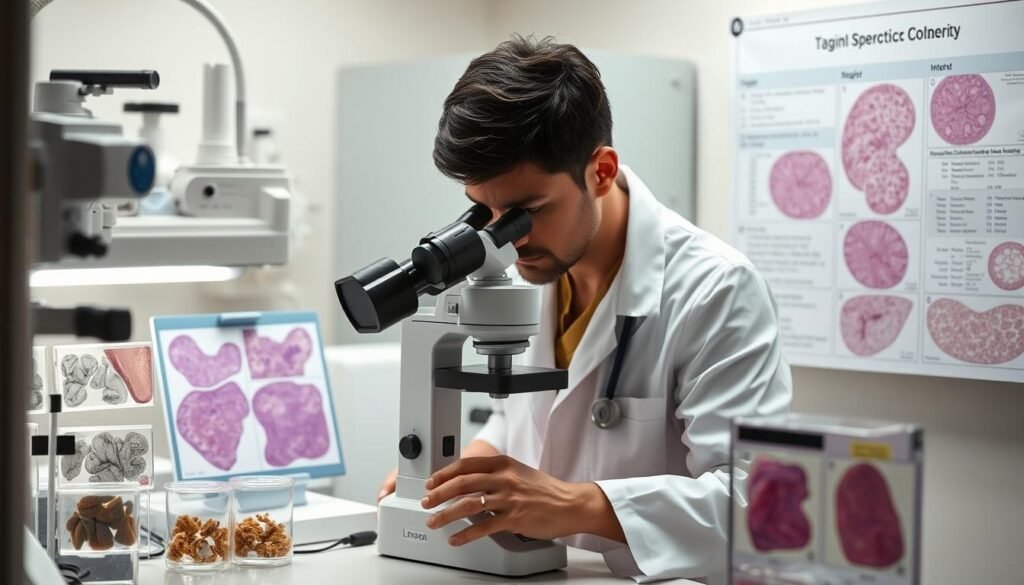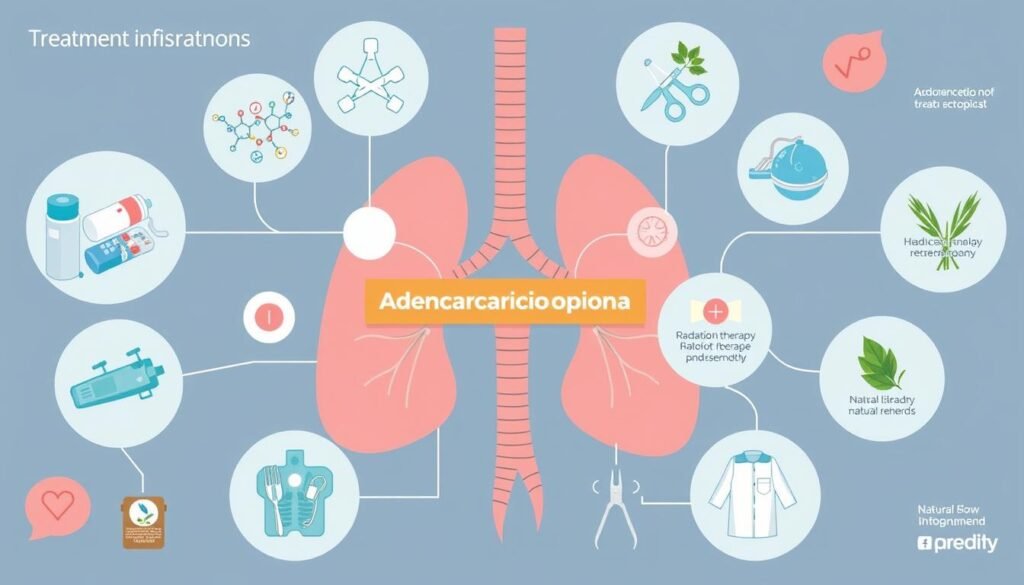Did you know lung adenocarcinoma makes up about 40% of all lung cancers? It’s the most common type among non-smokers. This fact highlights how vital it is to know about treatment options. Adenocarcinoma starts in glandular cells found in many organs like the lungs, pancreas, and colon.
The success of treatment depends on the cancer’s type, stage, and the patient’s health. By understanding adenocarcinoma treatment options, patients and their families can better manage their healthcare journey.
Key Takeaways
- Lung adenocarcinoma represents a significant portion of lung cancer cases.
- It tends to be more prevalent among women and younger individuals.
- Stage 0 NSCLC is often highly treatable through surgery alone.
- Personalized treatment strategies are crucial for effective adenocarcinoma treatment.
- Quitting smoking after a lung cancer diagnosis can improve outcomes.
- Isolation of targeted therapies can enhance treatment for specific genetic mutations.
Understanding Adenocarcinoma and Its Impacts
Adenocarcinoma is a major challenge in cancer care due to its different types and effects. It is the most common form of lung cancer, making up 40% of cases. This cancer also affects other organs greatly. For example, it represents 99% of prostate cancers and over 90% of stomach cancers.
Adenocarcinoma’s impact is not just about numbers. Being diagnosed with it can cause a lot of fear and worry about what comes next. But understanding how adenocarcinoma grows and spreads can help patients deal with these feelings better.
There are many factors that affect how a patient with adenocarcinoma will do, like where the cancer is, what type it is, and how advanced it is. For instance, invasive ductal carcinoma, a type of adenocarcinoma, is very common in breast cancer. Colon and rectal cancers, too, are mostly adenocarcinomas, making up 95% of cases. This shows why it’s crucial to know about this disease.
It’s also vital for patients to find support for their social and emotional needs during treatment. This kind of support helps keep a patient’s mental health strong while dealing with cancer. Finding a community or close relationships can really help overcome adenocarcinoma’s challenges.
In short, knowing about adenocarcinoma helps patients get ready for their treatment journey. It leads to a better-handled fight against cancer.
Types of Adenocarcinoma
Adenocarcinoma includes many types of cancers that start in glandular tissues. This cancer affects different organs. It’s key to know the types of adenocarcinoma for clear cancer classification. The most common types are:
- Lung Adenocarcinoma: Making up almost 40 percent of all non-small cell lung cancers (NSCLC). It’s often found in nonsmokers. It usually affects women and younger people more.
- Pancreatic Adenocarcinoma: This type is very aggressive. Often, it’s found too late, making treatment difficult.
- Colorectal Adenocarcinoma: It starts in the colon or rectum. It’s among the top causes of cancer deaths.
- Gastric Adenocarcinoma: Begins in the stomach lining. Its symptoms are usually unclear, leading to a late diagnosis.
- Breast Adenocarcinoma: Includes different forms, with invasive ductal carcinoma being the most common. It spreads to close tissues.
Every one of these adenocarcinoma variants has its own features and needs special treatments. Knowing these types is important for cancer care that meets your needs. Your treatment plan greatly depends on the adenocarcinoma you have. Regular checks and tests are key for managing the disease. They improve the odds of beating it. For more details, check out Adenocarcinoma Resources.
Diagnosis and Staging of Adenocarcinoma
The Diagnosis of Adenocarcinoma requires a few steps to find cancer cells. First, doctors use imaging tests and biopsies. This helps them know for sure if it’s cancer before starting treatment.
To know how far cancer has spread, staging is used. Cancer Staging looks at tumor size, affected lymph nodes, and if it has spread. This info helps plan the right treatment and guess the outcome.
The TNM staging system is a common way to grade cancer. It looks at the main tumor (T), lymph nodes (N), and metastasis (M). This method is key in figuring out:
- Where the tumor is
- How big it is and how much it has spread
- If nearby lymph nodes are involved
- If it has spread far away
Getting the stage right is vital in the Adenocarcinoma Assessment. Here’s what each stage means:
| Stage | Description |
|---|---|
| Stage 0 | Abnormal cells that haven’t spread past nearby tissue. |
| Stage I | The tumor is small and in one place. |
| Stage II | The tumor is larger and may have reached nearby lymph nodes. |
| Stage III | The tumor is now in nearby tissues and might have reached lymph nodes. |
| Stage IV | The cancer has spread to other organs or far parts of the body. |
For more on how cancer is staged and what that means, visit the staging guidelines. Proper staging helps pick the best treatment and manage care for those with adenocarcinoma.

Treatment Options for Adenocarcinoma
Treatment for Adenocarcinoma usually needs more than one type of therapy tailored for each patient. It might include Surgery, Chemo, and Radiation. Each has its role based on the cancer stage and traits.
Surgical Intervention
Surgery is often the first treatment for Adenocarcinoma patients. It aims to take out the tumor and nearby tissues. If the cancer is caught early, surgery could often cure it. The choice between minimally invasive or open surgery depends on the tumor’s size and place.
Chemotherapy Overview
Chemo uses different drugs to kill cancer cells. It’s great for fast-growing cells, making it key in treatment plans. Despite its importance, Chemo can cause side effects like nausea and tiredness. A tailored regimen helps lessen these while making the treatment work better.
Radiation Therapy Explained
Radiation therapy uses powerful rays to kill cancer cells and shrink tumors. It can boost the results of Surgery or Chemo. The therapy might be given from outside the body or from inside, based on the cancer’s type and spot. Adding this method helps in increasing survival chances and lowering the cancer’s return.

Targeted Therapy for Adenocarcinoma
Targeted therapy is leading the way in cancer treatment. It uses a custom approach to fight specific types of adenocarcinoma. Unlike older treatments that affect all fast-growing cells, targeted therapies focus only on cancer cells. This reduces side effects and is often the preferred option for many patients.
How Targeted Therapies Work
Targeted therapies for adenocarcinoma attack the cancer’s DNA mistakes. They stop cancer cells from growing. Treatments like those targeting KRAS G12C, EGFR, and ALK mutations have shown good results in treating some adenocarcinomas.
Common Types of Targeted Therapy
There are many kinds of targeted therapies for adenocarcinoma. They work in different ways. Here are some key types:
- Tyrosine Kinase Inhibitors – They stop enzymes that help cancer cells divide.
- Antibody-Drug Conjugates (ADCs) – They connect targeted antibodies with drugs that kill cancer cells.
- Angiogenesis Inhibitors – They prevent new blood vessels from feeding tumors.
Tests like next-generation sequencing are vital. They find specific mutations in adenocarcinoma. This helps doctors know if targeted therapy will work. Pills and IV drugs offer different ways to get this treatment.

Targeted therapies bring big benefits, but cancers might eventually resist them. Side effects include diarrhea, liver issues, blood clots, and tiredness. Knowing these points helps patients get treatment that’s right for their adenocarcinoma type.
| Type of Targeted Therapy | Mechanism of Action | Examples |
|---|---|---|
| Tyrosine Kinase Inhibitors | Block growth signals in cancer cells | Erlotinib, Gefitinib |
| Antibody-Drug Conjugates | Deliver drug directly to cancer cells | ADO-Trastuzumab, Inotuzumab |
| Angiogenesis Inhibitors | Inhibit new blood vessel formation | Aflibercept, Bevacizumab |
Immunotherapy: A New Frontier in Cancer Treatment
Immunotherapy is changing the way we fight cancer. It turns the immune system into a powerful weapon against cancer. This approach is showing a lot of promise, especially in tough cases like adenocarcinoma. Scientists are working hard to find ways to make the immune system better at spotting and killing cancer cells.
One big step forward is with immune checkpoint inhibitors (ICIs). These help the immune system fight tumors better. As of July 31, 2023, the FDA has approved 11 ICIs for 20 different types of cancer. This includes cancers like adenocarcinoma. Drugs like ipilimumab (Yervoy) and pembrolizumab (Keytruda) are helping patients live longer, even with advanced cancer.
CAR T-cell therapy is also showing a lot of potential. While it’s mainly used for blood cancers right now, it could help treat adenocarcinoma and other hard-to-fight cancers. Researchers are testing these therapies to see how safe and effective they are. They are looking to change how we treat cancer.
There’s new hope for tackling pancreatic cancer with immunotherapy. Pancreatic cancer is hard to treat because it’s often found too late. Most of the time, chemotherapy doesn’t work well for it. Now, scientists are focusing on immunotherapy. This includes vaccine therapy to help the immune system recognize pancreatic cancer cells better.
The medical field is excited about these advances in treating adenocarcinoma with immunotherapy. It’s a big change in how we help patients with serious or returning cancers. For more information on the latest in immunotherapy research, you can look at this comprehensive analysis.
Managing Side Effects of Adenocarcinoma Treatment
Dealing with adenocarcinoma treatment can bring many side effects that affect daily life. It is key for patients and their families to understand these effects. This understanding helps patients work with their doctors to tackle side effects better. This leads to a smoother treatment process.
Common Side Effects and Coping Strategies
The treatment can cause several side effects like:
- Fatigue
- Nausea and vomiting
- Hair loss
- Loss of appetite and taste changes
- Cognitive difficulties often referred to as “Chemo Brain”
- Skin changes such as dryness and rash
- Gastrointestinal issues like constipation or diarrhea
- Pain and muscle weakness
There are ways to ease these side effects. Changing what you eat can help with nausea or tiredness. Light exercise might reduce weakness. It’s also important to talk about your feelings because anxiety or depression is common.
Importance of Supportive Care
Supportive care is vital for treating adenocarcinoma. It offers services that make life better during treatment. Support can mean nutritional advice, emotional help, and ways to manage pain. Keeping in touch with your healthcare team about side effects is crucial. This keeps the treatment path smoother.
| Common Side Effects | Coping Strategies |
|---|---|
| Fatigue | Regular light exercise and rest periods |
| Nausea | Small, frequent meals and anti-nausea medications |
| Hair Loss | Wigs and head coverings as needed |
| Cognitive Changes | Journaling and memory aids |
| Pain | Utilize prescribed pain medications and alternative therapies |
Focusing on supportive care and managing side effects helps patients improve their well-being. This enhances the quality of life during treatment.
Clinical Trials and Research Opportunities
Clinical trials are essential for pushing forward adenocarcinoma research and finding new cancer treatments. They give patients access to advanced therapies not yet widely available. Sadly, very few eligible cancer patients, about 3% to 6%, join these studies. This low participation slows progress, leaving over 90% of patients without potentially life-saving treatments.
Many barriers stop patients from joining trials. They might fear getting a placebo or worry about side effects. Some think trials are only for when everything else fails. Travel needs and time away from work or family also play a role. Plus, not getting enough support from doctors can make patients less likely to consider trials.
But joining clinical trials can offer access to groundbreaking treatments. Like immunotherapies, which have been life-changing for some cancers considered incurable before. These trials also help find the best ways to treat cancer, including therapy mixes and lower doses that cause fewer serious side effects.
The following table highlights the phases of clinical trials and their objectives:
| Phase | Objective |
|---|---|
| Phase I | Focuses on safety and determining dosage |
| Phase II | Examines specific cancer types and responses to experimental treatments |
| Phase III | Assesses whether new treatments are superior to existing ones |
| Phase IV | Evaluates long-term benefits and side effects of new treatments |
Joining a clinical trial can be a very good experience. It means getting close attention from your healthcare team, who monitor any side effects and your overall health closely. It’s also about knowing the real benefits of these trials, something we need to spread the word about. By being part of a trial, patients not only get new treatment options for themselves. They also help advance adenocarcinoma research and the development of innovative therapies.
Conclusion
Dealing with adenocarcinoma treatments can feel tough. Having strong Guidance on Adenocarcinoma Treatment helps patients make smart choices. Working closely with a healthcare team lets people shape their treatment to fit their needs and wishes. This way, they take charge of their health journey.
Also, learning more and joining support groups are key for handling cancer well. Knowing about new treatments, like immunotherapy, gives patients hope and control. Being proactive improves life quality and helps patients stay strong through tough times.
In the end, beating lung adenocarcinoma needs not just new treatments but also patients’ active involvement in their health choices. By working closely with their healthcare teams and keeping up with new studies, patients can face their challenges with confidence.